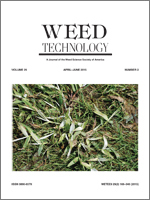Research was conducted to compare cotton and tomato response to volatility of 2,4-D, dicamba, and triclopyr formulations. Herbicide treatments were applied to tilled soil during August and September, and potted plants were placed in the center of treated strips. To quantify injury, leaf cupping/crinkling/drooping; leaf rolling/strapping; stem epinasty; and stem swelling/cracking were each visually rated on an injury scale of 0 to 5 (0 = none, 1 = slight, 2 = slight to moderate, 3 = moderate, 4 = moderate to severe, and 5 = severe). Leaf cupping/crinkling/drooping injury averaged across herbicide treatments at 1× rates was 1.0 for cotton and 2.0 for tomato 14 d after treatment (DAT). Averaged across crops, leaf cupping/crinkling/drooping injury for the 1× rates 14 DAT was equivalent for the 2,4-D dimethylamine (DMA) salt, 2,4-D acid, dicamba DMA salt, dicamba diglycolamine (DGA) salt, dicamba acid, and triclopyr acid formulations and ranged from 1.1 to 1.8. For tomato, the only herbicide treatments with injury 14 DAT no greater than for the nontreated were 1× rates of 2,4-D DMA and 2,4-D acid for leaf rolling/strapping (1.0); 2,4-D acid, dicamba DMA, dicamba acid, and triclopyr acid for stem epinasty (0.3 to 0.7); and 2,4-D DMA, 2,4-D acid, dicamba DMA, dicamba DGA, dicamba acid, and triclopyr acid for stem swelling/cracking (0.1 to 0.2). A weighted factor assigned to each injury criterion provided an overall total injury estimate of 0 to 100%. When applied at 1× rates, total injury for 2,4-D isooctyl ester was 10% for cotton and 36% for tomato and for triclopyr butoxyethyl ester was 11% for cotton and 50% for tomato. For the 2,4-D DMA, 2,4-D acid, dicamba DMA, dicamba DGA, dicamba acid, and triclopyr acid formulations, total injury was 4 to 8% for cotton and 20 to 24% for tomato, and for both crops, injury was no greater than for the nontreated.
Nomenclature: 2,4-D, dicamba, triclopyr; cotton, Gossypium hirsutum (L.); tomato, Solanum lycopersicum (L.).
Se realizó una investigación para comparar la respuesta del algodón y el tomate a la volatilidad de formulaciones de 2,4-D, dicamba, y triclopyr. Los tratamientos de herbicidas fueron aplicados durante Agosto y Septiembre, a suelo labrado, y plantas en potes fueron puestas en el centro de las franjas tratadas con el herbicida. Para cuantificar el daño, se evaluó visualmente el acucharamiento/arrugamiento/caída de las hojas, el enrollamiento de las hojas, la epinastia del tallo, y el engrosamiento/aparición de fisuras en el tallo, usando una escala de daño para cada variable de 0 a 5 (0 = nada, 1 = poco, 2 = poco a moderado, 3 = moderado, 4 = moderado a severo, y 5 = severo). El daño acucharamiento/arrugamiento/caída de hojas promediando los tratamientos de herbicidas a dosis de 1× fue 1.0 para algodón y 2.0 para tomate 14 d después del tratamiento (DAT). Promediando los cultivos, este mismo tipo de daño para dosis de 1× 14 DAT, fue equivalente para las formulaciones de sal de 2,4-D dimethylamine (DMA), ácido de 2,4-D, sal de dicamba DMA, sal de dicamba diglycolamine (DGA), ácido de dicamba, y ácido de triclopyr, y varió entre 1.1 y 1.8. En el tomate, los únicos tratamientos de herbicidas que tuvieron un daño que no fue mayor al testigo sin tratamiento a 14 DAT, fueron dosis 1× de 2,4-D DMA y ácido de 2,4-D, para el daño de enrollamiento de hojas (1.0); ácido de 2,4-D, dicamba DMA, ácido de dicamba, y ácido de triclopyr, para el daño de epinastia de tallo (0.3 a 0.7); y 2,4-D DMA, ácido de 2,4-D, dicamba DMA, dicamba DGA, ácido de dicamba, y ácido de triclopyr para el daño de engrosamiento del tallo (0.1 a 0.2). Un factor ponderado asignado para cada criterio de daño brindó un estimado general del total de daño de 0 a 100%. Cuando se aplicó la dosis de 1×, el daño total de 2,4-D isooctyl ester fue 10% para algodón y 36% para to





